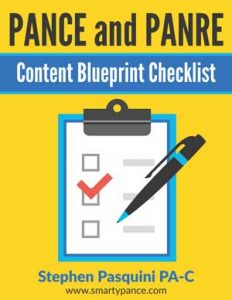Podcast: Play in new window | Download
Subscribe: Apple Podcasts | RSS
The Audio PANCE/PANRE PA Board Review Podcast
Welcome to episode 57 of the FREE Audio PANCE and PANRE Physician Assistant Board Review Podcast.
Join me as I cover ten PANCE and PANRE Board review questions from the SMARTYPANCE course content following the NCCPA™ content blueprint (download the FREE cheat sheet).
This week we will be covering ten endocrinology board review questions based on the NCCPA PANCE and PANRE Content Blueprint.
Below you will find an interactive exam to complement the podcast.
I hope you enjoy this free audio component to the examination portion of this site. The full board review includes over 2,000 interactive board review questions and is available to all members of the PANCE and PANRE Academy and SMARTYPANCE which are now bundled together into one very low price.
- You can download and listen to past FREE episodes here, on iTunes, on Google Play Music or Stitcher Radio.
- You can listen to the latest episode, take an interactive quiz and download your results below.
Listen Carefully Then Take The Practice Exam
If you can’t see the audio player click here to listen to the full episode.
Episode 57 – Endocrinology PANCE/PANRE Podcast Quiz
The following 10 questions are linked to NCCPA Content Blueprint lessons from the SMARTYPANCE and PANRE Board review website. If you are a member you will be able to log in and view this interactive video content.
1. A 53-year-old Hispanic woman comes to your clinic for her annual physical exam. She is obese, does not exercise, and regularly eats fried foods. A random blood glucose is 249 mg/dL. Her hemoglobin A1C is 9.5. Which of the following treatments would be weight neutral or cause weight loss in this patient?
A. Glargine
B. Glyburide
C. Actos
D. Metformin
E. Glipizide
Diabetes Mellitus Type 2 is covered as part of the NCCPA Endocrinology Content Blueprint which accounts for 6% of your exam.
2. A solitary thyroid nodule is noted on physical examination. The TSH level is normal. The next step in the evaluation is:
A. measurement of T4 and free T3 levels.
B. a radionuclide thyroid scan.
C. a fine needle biopsy.
D. a surgical excision.
Solitary thyroid nodule is covered as part of thyroid neoplastic disease in the NCCPA Endocrinology Content Blueprint which accounts for 6% of your exam.
3. An 18-year-old male with a past medical history of type I diabetes presents to the emergency room with polyuria, polydipsia, and dehydration. Vital signs reveal tachycardia and hypotension. The physical exam is significant for dry mucous membranes and decreased skin turgor. In the waiting room, he begins vomiting and complains of intense abdominal pain. You observe him taking rapid, deep breaths, and over the course of his brief stay, getting more somnolent. Which of the following abnormalities would be expected in this patient?
A. Hypernatremia
B. Decreased total body potassium
C. Hypoglycemia
D. Absence of urinary beta-OH-butyrate
E. Non-anion-gap metabolic acidosis
Diabetic ketoacidosis is covered under Diabetes Mellitus Type 1 as part of the NCCPA Endocrinology Content Blueprint which accounts for 6% of your exam.
4. A 30-year-old female complains of fatigue, weakness, diminished appetite, weight loss, and syncope. She denies fever, chest or abdominal pain, palpitations, changes in bowel patterns or sleep patterns. Physical examination reveals a thin female, BP 90/65 mmHg, and pulse 80 beats per minute. Pulmonary, cardiovascular, abdominal, and neurologic exam are without abnormalities. Areas of brown and bronze hyperpigmentation are noted on her elbows and the creases of her hands. Which of the following is the most likely diagnosis?
A. Addison’s disease
B. Cushing’s disease
C. Anorexia nervosa
D. Porphyria
This condition is covered as part of the NCCPA Endocrinology Content Blueprint and accounts for 6% of the exam
5. A 39-year-old male presents to your clinic complaining of increasing constant headaches and progressive loss of peripheral vision. His medical and family history is unremarkable. Physical examination reveals bitemporal hemianopsia but is otherwise without any abnormalities. Which of the following is the most likely diagnosis?
Answers
A. An aneurysm involving the circle of Willis
B. A migraine headache
C. Multiple sclerosis
D. Pituitary tumor
This condition is covered as part of the NCCPA Endocrinology Content Blueprint and accounts for 6% of the exam
6. Radioactive iodine is most successful in treating hyperthyroidism that results from
A. Grave’s disease.
B. subacute thyroiditis.
C. Hashimoto’s thyroiditis.
D. papillary thyroid carcinoma.
Watch this ReelDx Video of a 16-year-old with ADHD presents with chest pain and exophthalmos
Diseases of the thyroid gland are covered as part of the NCCPA Endocrinology Content Blueprint and accounts for 6% of the exam
7. A newborn infant exhibits prolonged jaundice, feeding problems, hypotonia, and an enlarged tongue. Proper treatment in this infant would consist of which of the following?
A. IV antibiotics
B. Thyroid hormone replacement
C. Hepatitis B immunoglobulin
D. Vitamin B6 supplement
This condition is covered as part of the NCCPA Endocrinology Content Blueprint and accounts for 6% of the exam
8. Which of the following glucose-lowering agents act by delaying glucose absorption?
A. Metformin (Glucophage)
B. Acarbose (Precose)
C. Glipizide (Glucotrol)
D. Pioglitazone (Actos)
Diabetes Mellitus Type 2 and associated medications are covered as part of the NCCPA Endocrinology Content Blueprint which accounts for 6% of your exam.
9. Which of the following conditions may result in hypokalemia?
A. Adrenal adenoma
B. Hypoparathyroidism
C. Hyperthyroidism
D. Adrenal insufficiency
Diseases of the Adrenal Glands are covered as part of the NCCPA Endocrinology Content Blueprint which accounts for 6% of your exam.
10. A 7-year-old child with a history of type 1 diabetes mellitus for 3 years presents for routine follow-up. The mother states that the child has been having nightmares and night sweats. Additionally, his average morning glucose readings have risen from an average of 100 mg/dL to 145 mg/dL over the past week. This child is most likely experiencing
A. a growth spurt.
B. emotional problems.
C. the Somogyi effect.
D. the dawn phenomenon.
The Somogyi effect and the dawn phenomenon are covered under Diabetes Mellitus Type 1 as part of the NCCPA Endocrinology Content Blueprint which accounts for 6% of your exam.
Looking for all the podcast episodes?
This FREE series is limited to every other episode, you can download and enjoy the complete audio series by joining The PANCE and PANRE Exam Academy + SMARTYPANCE
I will be releasing new episodes every few weeks. The Academy is discounted, so sign up now.
Resources and Links From The Show
- My list of recommended PANCE and PANRE review books
- Download the FREE PANCE and PANRE Blueprint Checklist
- Sign up for the FREE daily PANCE and PANRE email series
- Join the Smarty PANCE NCCPA Content Blueprint Website + The PA Life Academy
- View Tetrology of Fallot Picmonic: Use Code “SMARTYPANCE” to get 20% OFF any year-long Picmonic Membership
- USE CODE “PALIFE” TO GET 10% OFF THE RUTGERS PANCE AND PANRE REVIEW COURSE
This Podcast is also available on iTunes and Stitcher Radio for Android
- iTunes: The Audio PANCE AND PANRE Podcast iTunes
- Stitcher Radio: The Audio PANCE and PANRE Podcast Stitcher
Download The Content Blueprint Checklist
Follow this link to download your FREE copy of the Content Blueprint Checklist
Print it up and start crossing out the topics you understand, marking the ones you don’t and making notes of key terms you should remember. The PDF version is interactive and linked directly to the individual lessons on SMARTY PANCE.



